Page 883 of 2543
MASTER CYLINDER COMPONENTS
INSPECTION
HINT: Clean the disassembled parts with compressed air.
1. INSPECT CYLINDER BORE FOR RUST OR SCORING
2. INSPECT CYLINDER FOR WEAR OR DAMAGE
If necessary, clean or replace the cylinder.
MASTER CYLINDER INSTALLATION
1. ADJUST LENGTH OF BRAKE BOOSTER PUSH ROD
BEFORE INSTALLING MASTER CYLINDER
(See page BR±16)
2. INSTALL MASTER CYLINDER
Install the master cylinder and a new gasket on the brake
booster with the 2 nuts.
Torque: 13 NVm (130 kgfVcm, 9 ftVlbf)
3. CONNECT BRAKE LINES
Using SST, connect the brake 2 lines to the master cylinder.
Torque the union nuts.
SST 09751±36011
Torque: 15 NVm (155 kgfVcm, 11 ftVlbf)
4. CONNECT LEVEL WARNING SWITCH CONNECTOR
5. FILL BRAKE RESERVOIR WITH BRAKE FLUID AND
BLEED BRAKE SYSTEM
(See page BR±7)
6. w/ TRAC:
BLEED TRAC SYSTEM
(See page BR±9)
7. CHECK FOR FLUID LEAKAGE
8. CHECK AND ADJUST BRAKE PEDAL
(See page BR±6) BR±14
± BRAKE SYSTEMMASTER CYLINDER
Page 885 of 2543

BRAKE BOOSTER INSTALLATION
1. INSTALL BRAKE BOOSTER
(a) Install the booster and a new gasket.
(b) Install and torque the booster installation nuts.
Torque: 12 NVm (125 kgfVcm, 9 ftVlbf)
(c) Insert the clevis pin into the clevis and brake pedal, and install
the clip to the clevis pin.
(d) Install the pedal return spring.
2. ADJUST LENGTH OF BOOSTER PUSH ROD
(a) Install the gasket on the master cylinder.
(b) Set the SST on the gasket, and lower the pin until its tip
slightly touches the piston.
SST 09737±00010
(c) Turn the SST upside down, and set it on the booster.
SST 09737±00010
(d) Measure the clearance between the booster push rod and
pin head (SST).
Clearance:
0 mm (0 in.)
(e) Adjust the booster push rod length until the push rod lightly
touches the pin head.
HINT: When adjusting the push rod, depress the brake pedal
enough so that the push rod sticks out.
3. INSTALL PEDAL BRACKET STAY
(a) Install the pedal bracket stay.
(b) Install the bolt and nut.
(c) Install the steering column assembly. (See page SR±21)
4. INSTALL THESE PARTS:
wVacuum hose
wMaster cylinder (See page BR±14)
w/ TRAC:
wTRAC pump assembly (See page BR±118)
wTRAC actuator assembly (See page BR±121)
5. FILL BRAKE RESERVOIR WITH BRAKE FLUID AND
BLEED BRAKE SYSTEM (See page BR±7)
6. w/TRAC:
BLEED TRAC SYSTEM (See page BR±9)
7. CHECK FOR FLUID LEAKAGE
8. CHECK AND ADJUST BRAKE PEDAL (See page BR ±6)
9. DO OPERATIONAL CHECK (See page BR±7) BR±16
± BRAKE SYSTEMBRAKE BOOSTER
Page 888 of 2543
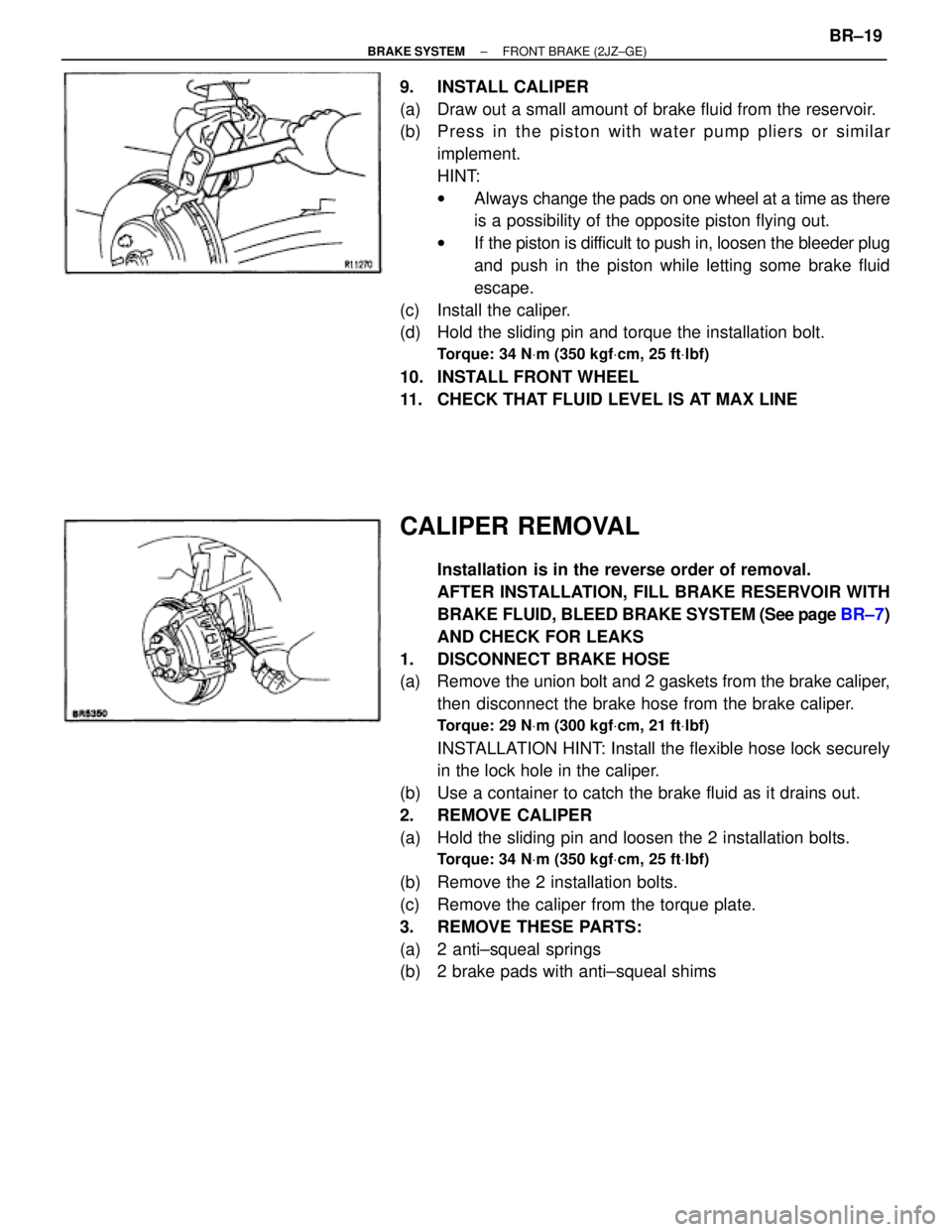
9. INSTALL CALIPER
(a) Draw out a small amount of brake fluid from the reservoir.
(b) P re ss in th e pisto n with wa te r pu mp plie rs or simila r
implement.
HINT:
wAlways change the pads on one wheel at a time as there
is a possibility of the opposite piston flying out.
wIf the piston is difficult to push in, loosen the bleeder plug
and push in the piston while letting some brake fluid
escape.
(c) Install the caliper.
(d) Hold the sliding pin and torque the installation bolt.
Torque: 34 NVm (350 kgfVcm, 25 ftVlbf)
10. INSTALL FRONT WHEEL
11. CHECK THAT FLUID LEVEL IS AT MAX LINE
CALIPER REMOVAL
Installation is in the reverse order of removal.
AFTER INSTALLATION, FILL BRAKE RESERVOIR WITH
BRAKE FLUID, BLEED BRAKE SYSTEM (See page BR±7)
AND CHECK FOR LEAKS
1. DISCONNECT BRAKE HOSE
(a) Remove the union bolt and 2 gaskets from the brake caliper,
then disconnect the brake hose from the brake caliper.
Torque: 29 NVm (300 kgfVcm, 21 ftVlbf)
INSTALLATION HINT: Install the flexible hose lock securely
in the lock hole in the caliper.
(b) Use a container to catch the brake fluid as it drains out.
2. REMOVE CALIPER
(a) Hold the sliding pin and loosen the 2 installation bolts.
Torque: 34 NVm (350 kgfVcm, 25 ftVlbf)
(b) Remove the 2 installation bolts.
(c) Remove the caliper from the torque plate.
3. REMOVE THESE PARTS:
(a) 2 anti±squeal springs
(b) 2 brake pads with anti±squeal shims
± BRAKE SYSTEMFRONT BRAKE (2JZ±GE)BR±19
Page 892 of 2543
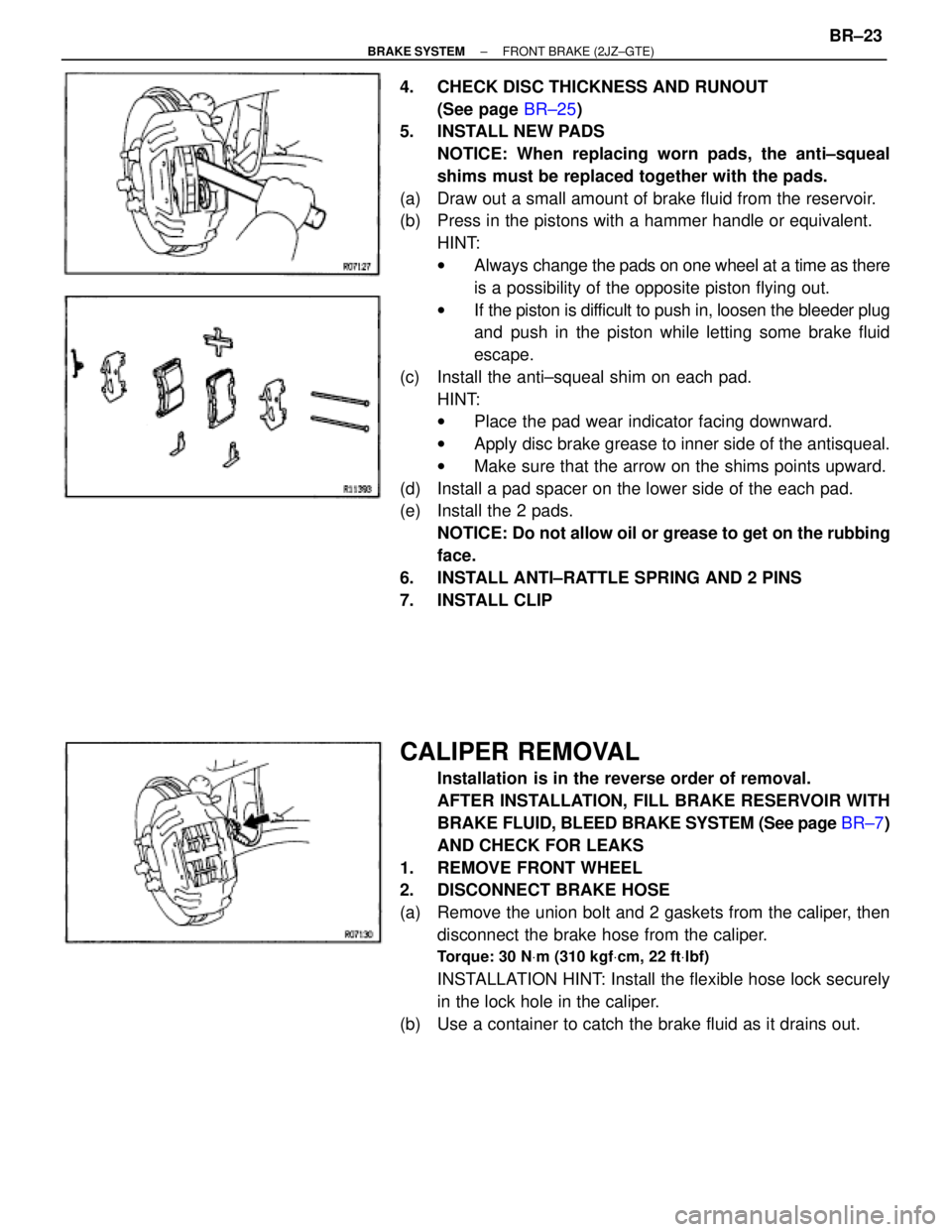
4. CHECK DISC THICKNESS AND RUNOUT
(See page BR±25)
5. INSTALL NEW PADS
NOTICE: When replacing worn pads, the anti±squeal
shims must be replaced together with the pads.
(a) Draw out a small amount of brake fluid from the reservoir.
(b) Press in the pistons with a hammer handle or equivalent.
HINT:
wAlways change the pads on one wheel at a time as there
is a possibility of the opposite piston flying out.
wIf the piston is difficult to push in, loosen the bleeder plug
and push in the piston while letting some brake fluid
escape.
(c) Install the anti±squeal shim on each pad.
HINT:
wPlace the pad wear indicator facing downward.
wApply disc brake grease to inner side of the antisqueal.
wMake sure that the arrow on the shims points upward.
(d) Install a pad spacer on the lower side of the each pad.
(e) Install the 2 pads.
NOTICE: Do not allow oil or grease to get on the rubbing
face.
6. INSTALL ANTI±RATTLE SPRING AND 2 PINS
7. INSTALL CLIP
CALIPER REMOVAL
Installation is in the reverse order of removal.
AFTER INSTALLATION, FILL BRAKE RESERVOIR WITH
BRAKE FLUID, BLEED BRAKE SYSTEM (See page BR±7)
AND CHECK FOR LEAKS
1. REMOVE FRONT WHEEL
2. DISCONNECT BRAKE HOSE
(a) Remove the union bolt and 2 gaskets from the caliper, then
disconnect the brake hose from the caliper.
Torque: 30 NVm (310 kgfVcm, 22 ftVlbf)
INSTALLATION HINT: Install the flexible hose lock securely
in the lock hole in the caliper.
(b) Use a container to catch the brake fluid as it drains out.
± BRAKE SYSTEMFRONT BRAKE (2JZ±GTE)BR±23
Page 896 of 2543
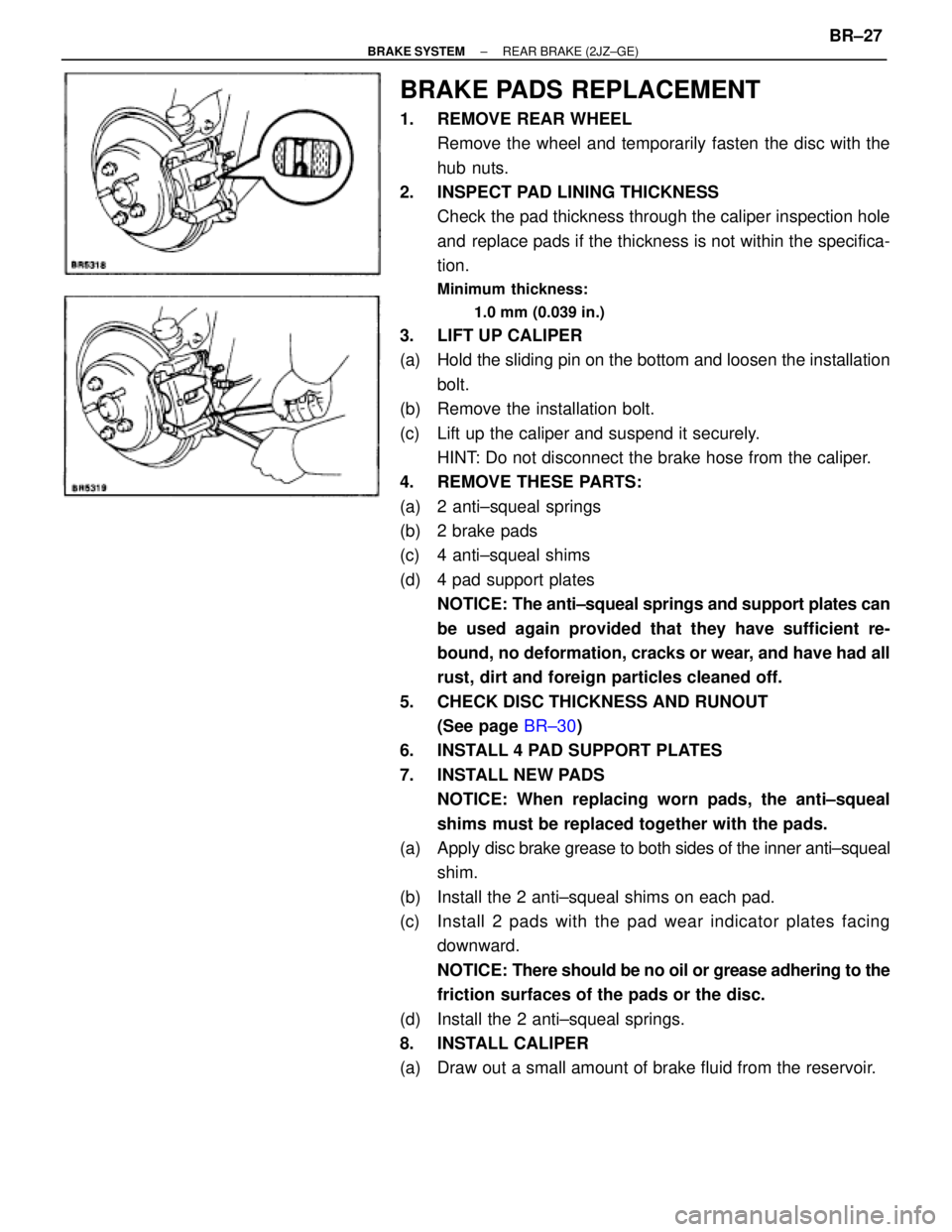
BRAKE PADS REPLACEMENT
1. REMOVE REAR WHEEL
Remove the wheel and temporarily fasten the disc with the
hub nuts.
2. INSPECT PAD LINING THICKNESS
Check the pad thickness through the caliper inspection hole
and replace pads if the thickness is not within the specifica-
tion.
Minimum thickness:
1.0 mm (0.039 in.)
3. LIFT UP CALIPER
(a) Hold the sliding pin on the bottom and loosen the installation
bolt.
(b) Remove the installation bolt.
(c) Lift up the caliper and suspend it securely.
HINT: Do not disconnect the brake hose from the caliper.
4. REMOVE THESE PARTS:
(a) 2 anti±squeal springs
(b) 2 brake pads
(c) 4 anti±squeal shims
(d) 4 pad support plates
NOTICE: The anti±squeal springs and support plates can
be used again provided that they have sufficient re-
bound, no deformation, cracks or wear, and have had all
rust, dirt and foreign particles cleaned off.
5. CHECK DISC THICKNESS AND RUNOUT
(See page BR±30)
6. INSTALL 4 PAD SUPPORT PLATES
7. INSTALL NEW PADS
NOTICE: When replacing worn pads, the anti±squeal
shims must be replaced together with the pads.
(a) Apply disc brake grease to both sides of the inner anti±squeal
shim.
(b) Install the 2 anti±squeal shims on each pad.
(c) Install 2 pads with the pad wear indicator plates facing
downward.
NOTICE: There should be no oil or grease adhering to the
friction surfaces of the pads or the disc.
(d) Install the 2 anti±squeal springs.
8. INSTALL CALIPER
(a) Draw out a small amount of brake fluid from the reservoir.
± BRAKE SYSTEMREAR BRAKE (2JZ±GE)BR±27
Page 897 of 2543
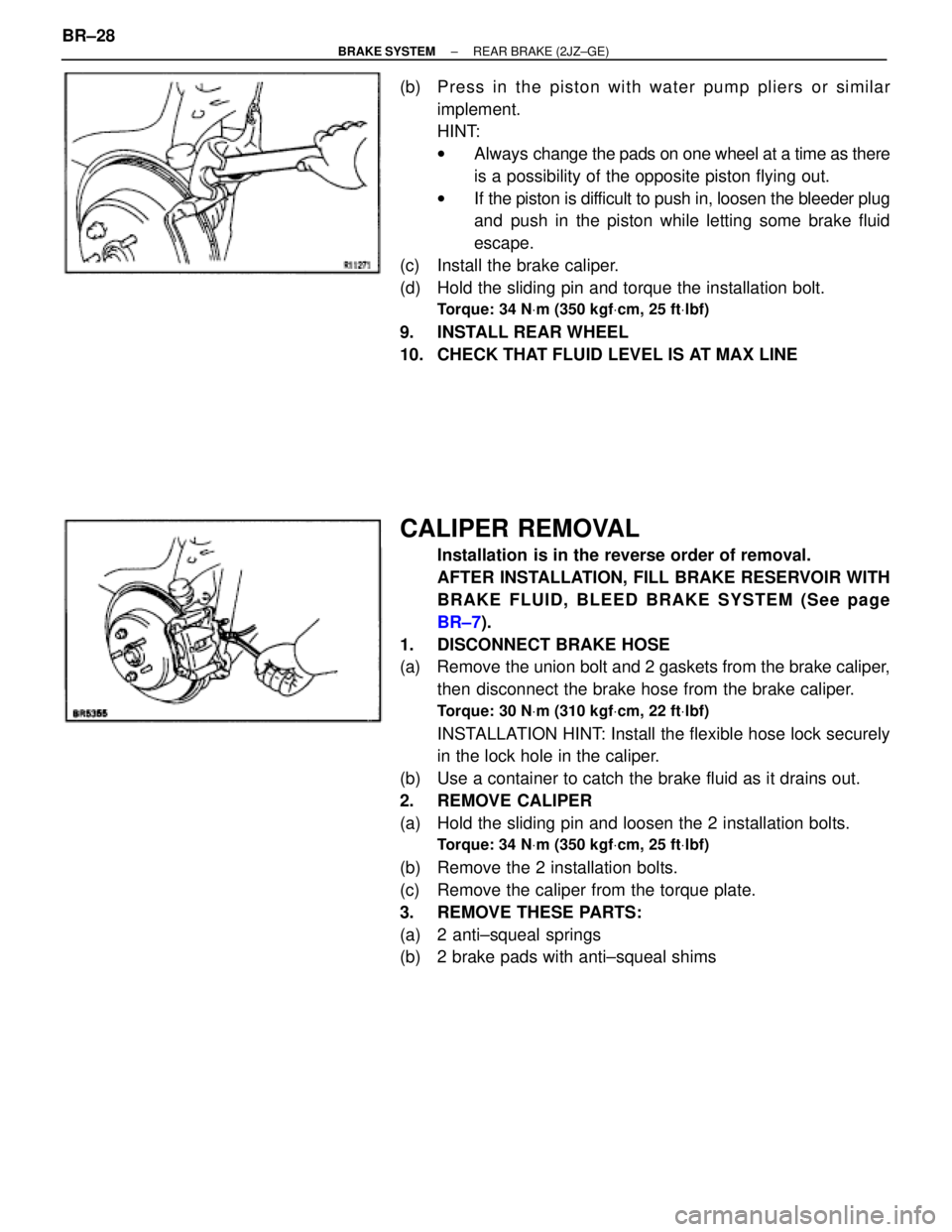
(b) Press in the piston with water pump pliers or similar
implement.
HINT:
wAlways change the pads on one wheel at a time as there
is a possibility of the opposite piston flying out.
wIf the piston is difficult to push in, loosen the bleeder plug
and push in the piston while letting some brake fluid
escape.
(c) Install the brake caliper.
(d) Hold the sliding pin and torque the installation bolt.
Torque: 34 NVm (350 kgfVcm, 25 ftVlbf)
9. INSTALL REAR WHEEL
10. CHECK THAT FLUID LEVEL IS AT MAX LINE
CALIPER REMOVAL
Installation is in the reverse order of removal.
AFTER INSTALLATION, FILL BRAKE RESERVOIR WITH
BRAKE FLUID, BLEED BRAKE SYSTEM (See page
BR±7).
1. DISCONNECT BRAKE HOSE
(a) Remove the union bolt and 2 gaskets from the brake caliper,
then disconnect the brake hose from the brake caliper.
Torque: 30 NVm (310 kgfVcm, 22 ftVlbf)
INSTALLATION HINT: Install the flexible hose lock securely
in the lock hole in the caliper.
(b) Use a container to catch the brake fluid as it drains out.
2. REMOVE CALIPER
(a) Hold the sliding pin and loosen the 2 installation bolts.
Torque: 34 NVm (350 kgfVcm, 25 ftVlbf)
(b) Remove the 2 installation bolts.
(c) Remove the caliper from the torque plate.
3. REMOVE THESE PARTS:
(a) 2 anti±squeal springs
(b) 2 brake pads with anti±squeal shims BR±28
± BRAKE SYSTEMREAR BRAKE (2JZ±GE)
Page 901 of 2543
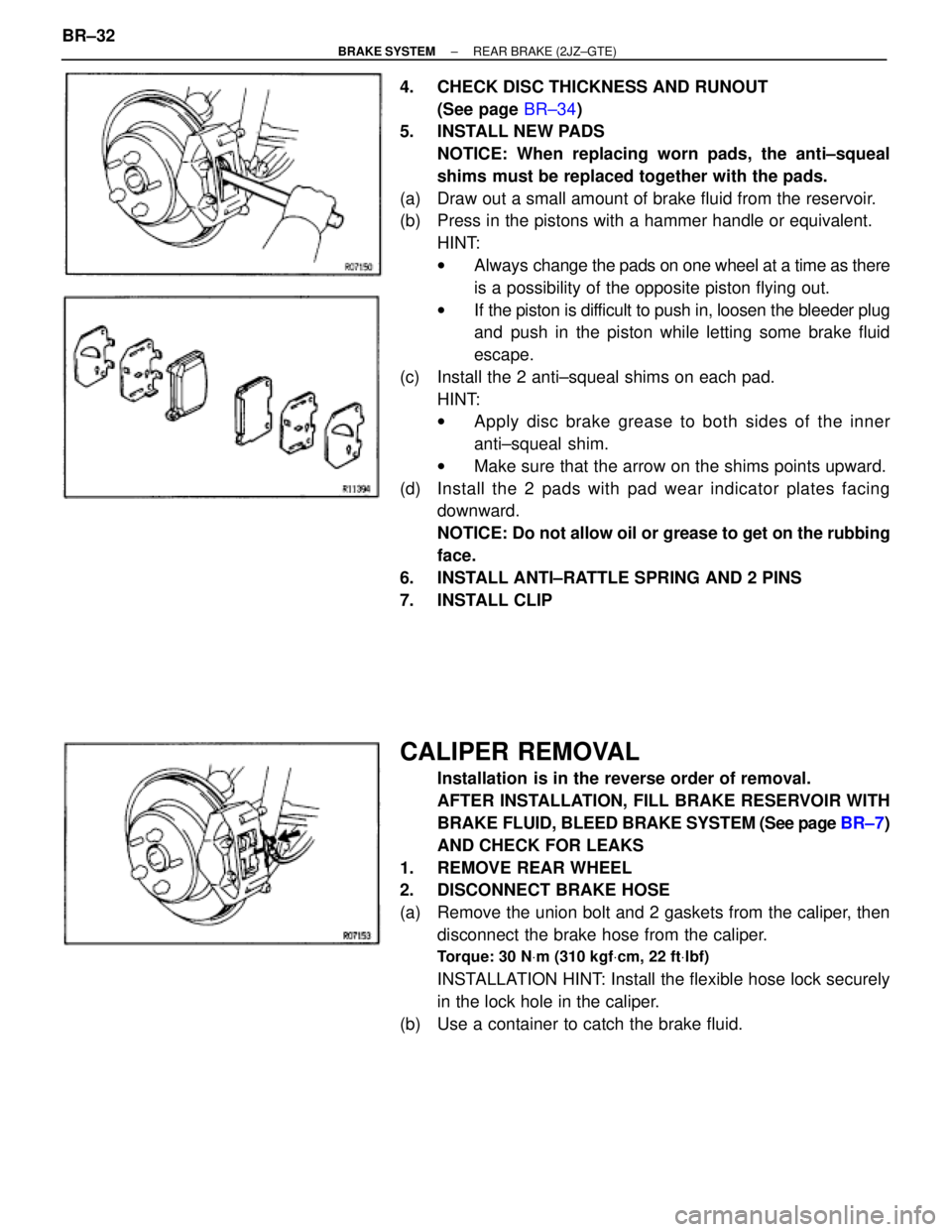
4. CHECK DISC THICKNESS AND RUNOUT
(See page BR±34)
5. INSTALL NEW PADS
NOTICE: When replacing worn pads, the anti±squeal
shims must be replaced together with the pads.
(a) Draw out a small amount of brake fluid from the reservoir.
(b) Press in the pistons with a hammer handle or equivalent.
HINT:
wAlways change the pads on one wheel at a time as there
is a possibility of the opposite piston flying out.
wIf the piston is difficult to push in, loosen the bleeder plug
and push in the piston while letting some brake fluid
escape.
(c) Install the 2 anti±squeal shims on each pad.
HINT:
wApply disc brake grease to both sides of the inner
anti±squeal shim.
wMake sure that the arrow on the shims points upward.
(d) Install the 2 pads with pad wear indicator plates facing
downward.
NOTICE: Do not allow oil or grease to get on the rubbing
face.
6. INSTALL ANTI±RATTLE SPRING AND 2 PINS
7. INSTALL CLIP
CALIPER REMOVAL
Installation is in the reverse order of removal.
AFTER INSTALLATION, FILL BRAKE RESERVOIR WITH
BRAKE FLUID, BLEED BRAKE SYSTEM (See page BR±7)
AND CHECK FOR LEAKS
1. REMOVE REAR WHEEL
2. DISCONNECT BRAKE HOSE
(a) Remove the union bolt and 2 gaskets from the caliper, then
disconnect the brake hose from the caliper.
Torque: 30 NVm (310 kgfVcm, 22 ftVlbf)
INSTALLATION HINT: Install the flexible hose lock securely
in the lock hole in the caliper.
(b) Use a container to catch the brake fluid. BR±32
± BRAKE SYSTEMREAR BRAKE (2JZ±GTE)
Page 909 of 2543
PROPORTIONING AND BY±PASS
VALVE (P & B VALVE)
FLUID PRESSURE INSPECTION
1. INSTALL LSPV GAUGE (SST) AND BLEED AIR
SST 09709±29017
2. RAISE MASTER CYLINDER PRESSURE AND CHECK
REAR WHEEL CYLINDER PRESSURE
2JZ±GTE:
����������� �����������Master cylinder pressure������������ ������������Rear wheel cylinder pressure
����������� �
���������� �����������
2,452 kPa
(25 kgf/cm2, 356 psi)
������������ �
����������� ������������
2,452 kPa
(25 kgf/cm2, 356 psi)
����������� �
���������� �����������
7,845 kPa
(80 kgf/cm2, 1,138 psi)
������������ �
����������� ������������
4,452 kPa
(45.4 kgf/cm2, 646 psi)
BR±40± BRAKE SYSTEMPROPORTIONING AND BY±PASS VALVE (P & B VALVE)